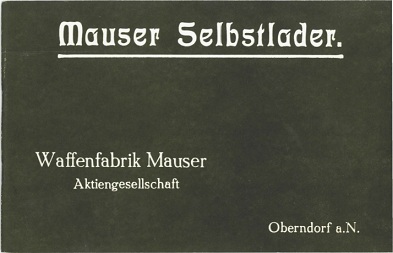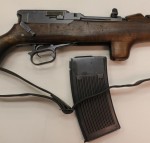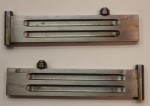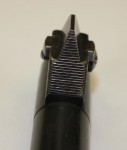The history of the Mauser semi-automatic rifles begins under questionable circumstances. The line of rifles began in 1897 with Paul Mauser’s development of the Mauser 1898 Recoil-Operated Rifle. This original rifle operated by the means of short recoil, where the breech block is cycled by means of a partially-traversing barrel. Interestingly, this original rifle had a provision that was to allow for “slow fire” manual firing whereby on the rearward movement of the breech block, it would snag a latch that would need to be depressed for the bolt to be allowed to travel back toward the barrel and strip a new round from the magazine. This provision was considered as a way to prevent the waste of ammunition, and the self-loading feature was only to be used in an emergency that required a high rate of fire. Unfortunately for Paul Mauser, the rifle provided an emergency of its own and, during testing of the rifle, a malfunction cost Paul Mauser one of his eyes.
Despite personal injury, development of Mauser’s self-loading rifles continued. In 1905, a new rifle appeared utilizing an entirely different method of operation. Unlike the short-recoil action of the Model 1898, the Model 1905 Self-loading Rifle (Sometimes referred to as the Model 1902) used the method of long-recoil, whereby the barrel and breech block, locked together, recoil laterally the entire length of recoil before disengaging. The most identifiable feature of this rifle is the pivoting bolt-handle that appears much like that of a bolt-action rifle, except located near the very front end of the bolt. The bolt-catch feature of the Model 1898 was absent in this design, but once again Mauser did give the rifle the provision for manual operation. If the pivoting bolt handle was turned down (locked, as in the case of a bolt-action rifle), the rifle would be prevented from operating semi-automatically. The magazine was internal and held 5 rounds.
Abandoning both the short- and long-recoil designs, the next iteration of the Mauser Self-loading Rifle came in 1908 with what was essentially an upscaled version of Mauser’s C06/08 pistol. The first apparent difference between the Mauser 06/08 Self-loading Rifle and the previous two Mauser self-loaders is the relatively massive magazine size. Opting not for an internal magazine, the 06/08 rifle introduced a 20-round detachable magazine. In fact due to the nature of the weapon’s operation, an internal magazine would have been extremely difficult, if not practically impossible to load.
The method of operation for the 06/08 rifle was by a fixed barrel and a delayed-blowback action. When the rifle is in battery, two pivoting lugs in a V-shape join together behind the breech block to prevent the block from recoiling rearwards, locking it in place. When the rifle is fired, recoil instead operates a slide that is positioned atop the receiver that is attached to the two locking lugs via cams cut into it. As the slide moves rearward, it opens the two lugs so they sit flush against the walls of the receiver, which finally allows the impulse of recoil to drive the bolt rearward. With the slide locked back in place, the bolt is free to travel forward again, stripping a round from the magazine into the chamber. Thereafter the slide is released, which again locks the lugs behind the breech block and enables the firing pin to be engaged.
It was an unnecessarily complicated design, and reloading the weapon was a laborious two-handed affair. Just to load the weapon fresh, the slide must be pulled back and manually locked into place, so that the locking lugs are retracted. With a hold-open device keeping the slide rearward, the bolt can then be pulled rearward and let go to strip a new round into the magazine. Then, the slide catch must be released, so that the weapon is fully in battery. Despite the overwhelming complication of the design, the 06/08 rifle was the longest-lived mechanism of the Mauser self-loaders. The same design principle was carried over into the final and most notable model of the Mauser self-loader: The Selbstlader-Karabiner Mauser M 1916.
The Selbstlader-Karabiner Mauser M 1916 was a further refinement of the 06/08 rifle, and its most notable features was a more ergonomic stock and an overall reduction in length. The 06/08 rifle had been tested as an aviation rifle, but its length was unwieldy. A rifle soon appeared with the same mechanism and a shorter half-length stock with a protrusion near the magazine well to aid in shouldering the rifle – this was designated as the Mauser 10/13 Self-loading Rifle. Undergoing military tests at the start of the First World War, the Mauser 10/13 rifle was ultimately rejected by the German Army proper, but found a home in the German Air Corps and the German Ballon-und-Zeppelin-Truppe. The German Air Corps adopted the rifle officially as the ‘Fliegerkarabine 15’ and the Ballon-und-Zeppelin-Truppe adopted the rifle officially as the ‘Selbstlader-Karabiner Mauser M 1916.’
Issued with multiple 20-round magazines, the volume of fire the rifle could lay down was impressive, but there was a catch– the rifle had to be meticulously clean to do so. Due to the expensive manufacturing costs and intricate high-tolerance machining, only 1000 of the Selbstlader-Karabiner Mauser M 1916 were produced. While the high-tolerance machining led to impressive mechanical accuracy, it suffered from easy fouling. For the rifle to operate reliably, rounds had to be properly lubricated in grease, making them a dirt-trap which kept the rifle in the air. Ground usage was out of the question. On top of the reliability concerns, there was the issue of the weapon’s punishing recoil. The fixed-barrel design led to the recoil impulse being much sharper as compared to other gas- or recoil-based mechanisms where the barrel or an operation rod would absorb some of the recoil. That was not so with the M 1916– the entire force of recoil was slammed back against the operator’s shoulder.
When the German military acquired sufficient numbers of the much cheaper Flieger-Selbstlader-Karabiner 15 Mondragon Rifle, the Mauser Fliegerkarabine 15 was largely withdrawn from the German Air Corps. The Flieger-Selbstlader-Karabiner 15 Mondragon was inherently less-accurate and more prone to stoppages according to its Bavarian Field Manual. It states that compared to the “previous introduced weapon,” being the Mauser Fliegerkarabine 15, accuracy of the newly-acquired weapons was abysmal:
“The unified construction of this self-loading weapon results in greater variations in the targeting position than exist in previously introduced weapons. Only deviations of more than 20cm from the normal group are corrected.”
For every one Mauser Fliegerkarabine 15 replaced, two Flieger-Selbstlader-Karabiner 15 Mondragon rifles took its place due to the frequency of stoppages. So even if the final Mauser self-loader was by no means a spectacular rifle and suffered from serious reliability issues, there were still objectively worse alternatives.
Manuals

Photos
Download this gallery in high resolution
Mauser M1915 photos:
Patents
US Patent #639,421 (P. Mauser; Recoil Operated Firearm; December 19, 1899)
US Patent #783,123 (P. Mauser; Recoil Operated Small Arms; February 21, 1905)
US Patent #903,998 (P. Mauser; Recoil Loading Small Arm [06/08 pistol]; November 17, 1908)
US Patent #987,584 (P. Mauser; Small Arm [06/08 rifle]; March 21, 1911)




















There is an issue with this article– none all of the weapons pictured (save for the first diagram) are of the title weapon, and the description of action is wrong for all but one of the pictures. In pictures 2-7, the weapons pictured are the Selbstlader-Karabiner M 1916/Fliegerkarabiner 15 (Also known as the Mauser 1910/13) in Picture 2, and the Mauser C06/08 Rifle in Pictures 3-7.
These two separate rifles did not operate via long-recoil action as the Mauser 1905 semi-automatic rifle did (you can see the diagrams in the first picture are for a completely separate system), but instead use a fixed-barrel, inertia-based blowback design that had been developed originally for Mauser’s C06/08 pistol (hence the change with the C06/08 rifle), viewable in US Patent #943949.
Regards
An interesting information about Mauser rifle systems,
Maybe you got this mauser G41 version to demonstrate??
This is more rare than G41 walther and unknown numbers of those where made,one fact is those mauser G41 models rests in private collections or museums…
Can I suppose the first comment is doesn’t apply to the new text now?
Yep – I replaced my poor description with this much better one that Pointless wrote for us.
Does the magazine look suspiciously like a forerunner for the MG13s?
I can see that but it looks like the real deal.
It does. The metal ribbing on the side is exactly the same, the capacity is the same, and the basic dimensions are the same. I’m unsure if they are fully compatible, but the logic behind it would make sense. The MG13 was based on a couple different Dreyse prototypes, one of the plans originally designed during the war in 1918 (the Dreyse Muskete). Using a magazine that was already in wartime production for a weapon in service (however limited it may have been) would make sense from a logistical point of view, though there is a question about the different plants that produced them (Rheinmetall for the MG-13)– and if they used the same tooling.
I have examined a Selbstlader-Karabiner Mauser M 1916 in a local collection of a well know WW1 and WW2 small arms collector, and the MG13 magazine will fit the rifle just fine. However, he has not fired the rifle so I do not know wether or not the rifle will properly feed from the MG13 magazine.
Danke shon..this is a wonderful vault of knowledge…bravo and keep the ballistic flags flying…I AM OF THE OPINION THAT THESE WEAPONS COULD HAVE UNALTERABLY CHANGED THE KALEIDOSCOPE OF THE FIRST WORLD WAR BATTLEFIELD IN VIRTUALLY EVERY RAMIFICATION…HANDING THE QUICK VICTORIES TO THE PRUSSIAN FORCES AND OUTFIGHT AND OUTSHOOT THE FAMED BEF fusiliers.
Yes, the magazines for the Selbstlader Model 1916 and the Mg-13 are fully interchangeable. While taking pictures of one I loaded an Mg-13 magazine with dummy 8mm ammo, and it fed just fine.
I did not expect that – thanks for the info!
I have a german Bavarian rifle by werder lightning military rifle 1893 model period eleven m.m. mauser single shot 35 inch barrel with three trigger one for opening the breach one foe firing the rifle and one makes the firing trigger a hair trigger. I can not find any info on this rifle can you help thanks george
I’m curious about the ultimate fate of the German Air Corps Mondragon-SIG rifles.
The German “Condor Legion”(Luftwaffe and armored units)supported Nationalist forces during the Spanish civil war of 1936-39. It would not be surprising to discover that Mondragon automatic rifles, WW1 surplus by then, were sold to Spain and then used in later conflicts…Does anyone know?
There are records of Mondragons being sold to both the Chinese and Japanese but who knows where they ended up. There is also supposedly accounts of these being fielded during the Battle of Berlin. Good luck finding any real concrete information on them.
I am looking for magazines for my 1916 Mauser semi-auto
Can anyone help?